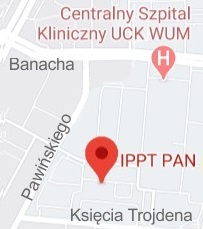| 1. |
Ślusarz R.♦, Sieradzan A.♦, Giełdoń A.♦, Lubecka E.♦, Ślusarz M.♦, Leśniewski M.♦, Nguyen T.♦, Liwo A.♦, Czaplewski C.♦, UNRES web server: Extensions to nucleic acids, prediction of peptide aggregation, and new types of restrained calculations,
Journal of Molecular Biology, ISSN: 0022-2836, DOI: 10.1016/j.jmb.2025.168968, Vol.437, No.15, pp.168968-1-9, 2025 Abstract:
The third version of the UNRES web server is described, in which the range of biological macromolecules treated and calculation types has been extended significantly. DNA and RNA molecules have been added to enable the user to run simulations of their folding/hybridization and dynamics. To increase the accuracy of the simulated proteins models, the restraints on secondary structure have been enhanced to include the probabilities of the coil, extended and helical state, which are taken from the PSIPRED or HHpred raw input and the restraints from multiple bioinformatics models have been added. The NMR-data-assisted functionality has been extended to include time-averaged restraints, this feature enabling the user to model multistate and intrinsically-disordered proteins and those with intrinsically-disordered regions. Finally, the prediction of the propensity of peptides to aggregation has been included to enable the user to predict peptide solubility and aggregation, including the character and the structures of the aggregates. Keywords:
protein and nucleic-acid structure prediction, peptide aggregation, coarse graining, molecular dynamics, time-averaged NMR Affiliations:
| Ślusarz R. | - | other affiliation | | Sieradzan A. | - | other affiliation | | Giełdoń A. | - | other affiliation | | Lubecka E. | - | other affiliation | | Ślusarz M. | - | other affiliation | | Leśniewski M. | - | other affiliation | | Nguyen T. | - | other affiliation | | Liwo A. | - | other affiliation | | Czaplewski C. | - | other affiliation |
|  |
| 2. |
Nguyen T.♦, Czaplewski C.♦, Lubecka E.♦, Liwo A.♦, Implementation of Time-Averaged Restraints with UNRES Coarse-Grained Model of Polypeptide Chains,
Journal of Chemical Theory and Computation, ISSN: 1549-9618, DOI: 10.1021/acs.jctc.4c01504, Vol.21, No.3, pp.1476-1493, 2025 Abstract:
Time-averaged restraints from nuclear magnetic resonance (NMR) measurements have been implemented in the UNRES coarse-grained model of polypeptide chains in order to develop a tool for data-assisted modeling of the conformational ensembles of multistate proteins, intrinsically disordered proteins (IDPs) and proteins with intrinsically disordered regions (IDRs), many of which are essential in cell biology. A numerically stable variant of molecular dynamics with time-averaged restraints has been introduced, in which the total energy is conserved in sections of a trajectory in microcanonical runs, the bath temperature is maintained in canonical runs, and the time-average-restraint-force components are scaled up with the length of the memory window so that the restraints affect the simulated structures. The new approach restores the conformational ensembles used to generate ensemble-averaged distances, as demonstrated with synthetic restraints. The approach results in a better fitting of the ensemble-averaged interproton distances to those determined experimentally for multistate proteins and proteins with intrinsically disordered regions, which puts it at an advantage over all-atom approaches with regard to the determination of the conformational ensembles of proteins with diffuse structures, owing to a faster and more robust conformational search. Affiliations:
| Nguyen T. | - | other affiliation | | Czaplewski C. | - | other affiliation | | Lubecka E. | - | other affiliation | | Liwo A. | - | other affiliation |
|  |
| 3. |
Leśniewski M.♦, Pyrka M.♦, Czaplewski C.♦, Nguyen Truong C.♦, Jiang Y.♦, Gong Z.♦, Tang C.♦, Liwo A.♦, Assessment of Two Restraint Potentials for Coarse-Grained Chemical-Cross-Link-Assisted Modeling of Protein Structures,
Journal of Chemical Information and Modeling, ISSN: 1549-9596, DOI: 10.1021/acs.jcim.3c01890, Vol.64, No.4, pp.1377-1393, 2024 Abstract:
The influence of distance restraints from chemical cross-link mass spectroscopy (XL-MS) on the quality of protein structures modeled with the coarse-grained UNRES force field was assessed by using a protocol based on multiplexed replica exchange molecular dynamics, in which both simulated and experimental cross-link restraints were employed, for 23 small proteins. Six cross-links with upper distance boundaries from 4 Å to 12 Å (azido benzoic acid succinimide (ABAS), triazidotriazine (TATA), succinimidyldiazirine (SDA), disuccinimidyl adipate (DSA), disuccinimidyl glutarate (DSG), and disuccinimidyl suberate (BS3)) and two types of restraining potentials ((i) simple flat-bottom Lorentz-like potentials dependent on side chain distance (all cross-links) and (ii) distance- and orientation-dependent potentials determined based on molecular dynamics simulations of model systems (DSA, DSG, BS3, and SDA)) were considered. The Lorentz-like potentials with properly set parameters were found to produce a greater number of higher-quality models compared to unrestrained simulations than the MD-based potentials, because the latter can force too long distances between side chains. Therefore, the flat-bottom Lorentz-like potentials are recommended to represent cross-link restraints. It was also found that significant improvement of model quality upon the introduction of cross-link restraints is obtained when the sum of differences of indices of cross-linked residues exceeds 150. Affiliations:
| Leśniewski M. | - | other affiliation | | Pyrka M. | - | other affiliation | | Czaplewski C. | - | other affiliation | | Nguyen Truong C. | - | other affiliation | | Jiang Y. | - | other affiliation | | Gong Z. | - | other affiliation | | Tang C. | - | other affiliation | | Liwo A. | - | other affiliation |
|  |


















